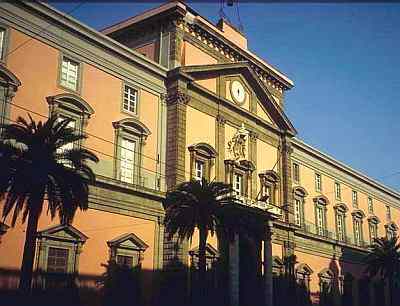The National Archaeological Museum is located at the corner of via Foria and via Costantinopoli. That point was also the northwest corner of the original Greek wall of the city of Neapolis, remains of which can be seen further down via Costantinopoli at Piazza Bellini. It is a fitting site for one of the most complete collections of Greek and Roman antiquities in the world, and one of the few places where they can be viewed side by side just a few yards from precisely that outside world where they, indeed, existed side by side for centuries.
Charles III of Bourbon founded the museum in the 1750s. He used a building erected in 1585, one that had served as a cavalry barracks and later, from 1616 to 1777, as the seat of the University of Naples. Expansion of the premises continued in the latter half of the eighteenth century under the supervision of Ferdinando Fuga and Pompeo Schiantarelli. A final project drawn up in 1790 to complete the structure was never completed.
The museum houses impressive collections from Pompei and Herculaneum; there are exhibits from other archaeological sites throughout southern Italy, including some from early non-Roman Italic peoples of the area, such as the Samnites. More recent additions include the Farnese collection and the Borgia collection of Egyptian antiquities, this latter giving the visitor the bonus of studying the very real commercial and social ties that the ancient Greek city had with its own forerunner, Egypt. Other collections contain items that in many other museums would be considered much more than 'miscellaneous', such as the 'Tazza Farnese,' one of the largest cameos in the world, crafted in Alexandria in 150 BC and that came into the possession of Lorenzo the Magnificent 15 centuries later
Jeff Matthews
Charles III of Bourbon founded the museum in the 1750s. He used a building erected in 1585, one that had served as a cavalry barracks and later, from 1616 to 1777, as the seat of the University of Naples. Expansion of the premises continued in the latter half of the eighteenth century under the supervision of Ferdinando Fuga and Pompeo Schiantarelli. A final project drawn up in 1790 to complete the structure was never completed.
The museum houses impressive collections from Pompei and Herculaneum; there are exhibits from other archaeological sites throughout southern Italy, including some from early non-Roman Italic peoples of the area, such as the Samnites. More recent additions include the Farnese collection and the Borgia collection of Egyptian antiquities, this latter giving the visitor the bonus of studying the very real commercial and social ties that the ancient Greek city had with its own forerunner, Egypt. Other collections contain items that in many other museums would be considered much more than 'miscellaneous', such as the 'Tazza Farnese,' one of the largest cameos in the world, crafted in Alexandria in 150 BC and that came into the possession of Lorenzo the Magnificent 15 centuries later
Jeff Matthews
Tell us what you think. Leave a comment

 RSS Feed
RSS Feed

